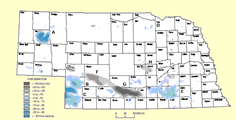Natural Resources, School of

Conservation and Survey Division: Faculty and Staff Publications
Document Type
Article
Date of this Version
3-2018
Citation
Diffendal, Robert F., Jr. 2015. Fossils on the Floor In the Nebraska State Capitol. Lincoln, Nebraska. Conservation and Survey Division, University of Nebraska-Lincoln, 58 pp.
Educational Circular 23, 2015. Revised September 2015; March 2018.
Abstract
The Nebraska State Capitol is a wonderful place. This building is home to great treasures of art owned by the people of Nebraska. The floor of the Capitol Rotunda has beautiful works of art. Maybe you have seen this art. Small pieces of two kinds of rocks make pictures of people, their tools, the natural resources they used, and pictures of fossil animals and plants. These kinds of pictures are called mosaics [moe ZAY icks]. The animals and plants follow one another in a curved ribbon around the floor. In that ribbon of pictures are many kinds of fossil animals and plants including some of the dinosaurs. This book will tell you some things about these fossils. The story of how the floor was made begins many years ago. In 1927 a famous paleontologist and teacher at the University of Nebraska in Lincoln heard that the new Capitol would have mosaics of fossil animals and plants like ones found in Nebraska and nearby states. That paleontologist was Professor Erwin H. Barbour [bar BORE], the third director of the University of Nebraska State Museum, also called Morrill Hall or Elephant Hall. Professor Barbour was asked to draw pictures of fossil plants and animals for artist Hildreth Meière [HILL dreth mee AIR] to copy. Professor Barbour was also a very talented artist. He drew many large colored pictures of fossil plants and animals and sent them to Miss Meière, who lived in New York City. She used some of these drawings to make some of the mosaic pictures of fossils on the Rotunda floor. People thought that all of Professor Barbour’s drawings were lost. A few years ago some were found and given to the people who work in the State Capitol. Now some of the beautiful pictures that Professor Barbour drew on tissue paper are preserved for the future. He used pastels, color sticks like crayons, to draw the pictures. He drew colored dinosaurs in 1927, long before anyone else thought that these animals had colored skins. Professor Barbour also drew pictures of fossil animals with a pen and black ink.
Included in
Environmental Education Commons, Geology Commons, Geomorphology Commons, Hydrology Commons, Paleontology Commons, Science and Mathematics Education Commons, Sedimentology Commons, Soil Science Commons, Stratigraphy Commons


Comments
EC-23 (revised)